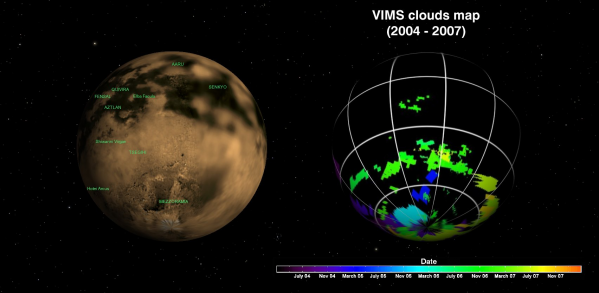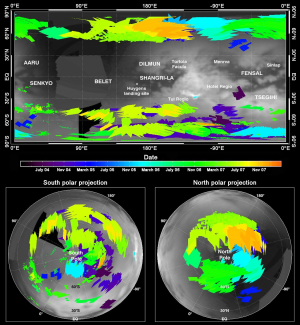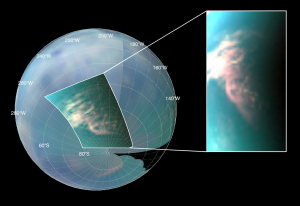Update: 06/08/2009

The atmosphere of Titan is home to a meteorological system involving methane and in a lesser way ethane, in seasonal cycles which involve lakes, evaporation, cloud formation and rain; much like water on Earth.
Since the first detection of a cloud in 1995, and then the first images obtained via ground telescopes and instruments on board Cassini, it has become clear that the atmosphere of Titan harbors a rich cloud cover. Sporadic methane cloud formations in the summer hemisphere, and stable ethane clouds completely covering the winter pole. However, these various observations were only giving temporary and incomplete information on the cloud cover of Titan.
Researchers from the University of Paris Diderot (member of the AIM laboratory), the Laboratory of Planetology and Geodynamics in Nantes and the Group of Molecular and Atmospheric Spectrometry in Reims, together with the scientific team of the VIMS instrument (Visual and Infrared Mapping Spectrometer) on board Cassini, edited the first cloud map of Titan by bringing together all the observations of VIMS over a period of three and a half years (between July 2004, when Cassini started orbiting Saturn, and December 2007). In that time, more than two hundred clouds were observed.

The spatial distribution of the clouds brought forward by this study gives clear insight on the atmosphere of Titan, and especially on the mechanisms behind its cloud cover. The clouds are distributed over the two polar regions and around a latitude of 40°S (see fig. opposite), thus confirming the major role played by the atmospheric circulation over the distribution of the clouds; as predicted by the climate model GCM-IPSL which includes cloud physics.
This model predicts sporadic methane cloud formation in the upward part of a convective cell around a latitude of 40° (the equivalent of the Hadley cell mechanism on Earth) in the summer hemisphere (southern hemisphere for the 2004 – 2007 time period). The phenomenon also occurs in secondary cells produced the poles, more so in the summer pole (south pole for the 2004 – 2007 time period).
In the winter pole (north pole for the 2004 – 2007 time period), and beyond 60° of latitude, ethane clouds are believed to form in the downward part of the stratospheric circulation when it goes through the cold barrier of the tropopause. These clouds, predicted by the model, are indeed observed by VIMS, which confirms for the first time at this scale the validity of these models.

However, the evolution of the cloud cover throughout the seasons is not so well understood. Like Earth, Titan is home to heavily differentiated seasonal cycles (succession of winters, springs, falls and summers) due to the strong inclination of its rotation axis. But Titan’s cycles last much longer. Ten times further from the Sun than Earth, Titan, pulled by Saturn, takes 29 years to rotate around the Sun, when the Earth only takes one. Due to this longer period, Titan’s seasons last around seven years.
The GCM-IPSL climate model for Titan predicted the evaporation of the clouds in the southern hemisphere (at the pole and around 40°S) with the change in circulation around the equinox in August 2009, and their return in the northern hemisphere (in a symmetrical way) during the opposite season starting in 2014. The model predicted the progressive evaporation of the clouds in the southern hemisphere as early as 2005 with the arrival of the fall, usually colder and dryer. But observations show that this evaporation is yet to take place.
Short movie on the cloud formation on Titan

Simulation of the cloud formation on Titan
This simulation (Titan’s Global Climate Model 2002-2009) was built using the data from the Titan cloud observation campaign lead by the VIMS instrument onboard Cassini between 2004 and 2007 (in french).
As the authors of this study showed, clouds still regularly appeared in 2007, which led scientists to believe the southern hemisphere was experiencing a warmer and more humid end of summer than what was predicted. This difference from climate models may show a higher inertia of Titan’s climate system than what was thought, which may be linked to the thermal inertia of the surface.
With the extension of the Cassini mission until 2017, the future observations may prove crucial in order to follow the evolution of the cloud cover when the circulation switches at the equinox. Monitoring and mapping the clouds at this time will enable to follow the atmospheric circulation during a quickly evolving period, and will provide useful insight on the dynamics of the atmospheric system of Titan.
All these observations should help improve the atmospheric circulation models of Titan; and, in a broader way, improve our understanding of how planetary atmospheres work, including on Earth.
Article references
Global circulation as the main source of cloud activity on Titan, Sébastien Rodriguez1,2, Stéphane Le Mouélic1, Pascal Rannou3,4, Gabriel Tobie1, Kevin H. Baines5, Jason W. Barnes6, Caitlin A. Griffith7, Mathieu Hirtzig8, Karly M. Pitman5, Christophe Sotin1,5, Robert H. Brown7, Bonnie J. Buratti5, Roger N. Clark9 & Phil D. Nicholson10, Nature, 4 june 2009.
1Laboratoire de Planétologie et Géodynamique, CNRS UMR 6112, Université de Nantes, 2 rue de la Houssinière, 44000 Nantes, France.
2Laboratoire AIM, Université Paris 7, CNRS UMR-7158, CEA-Saclay/DSM/IRFU/SAp, 91191 Gif/Yvette, France.
3Groupe de Spectrométrie Moléculaire et Atmosphérique, CNRS UMR-6089, Université de Reims Champagne-Ardenne, 51687 Reims, France.
4LATMOS, CNRS UMR-7620, Université Versailles-St-Quentin, 91371 Verrières-le-Buisson, France.
5Jet Propulsion Laboratory, California Institute of Technology, Pasadena, CA 91109-8099, USA.
6NASA Ames Research Center M/S 244-30, Moffett Field, California 94035, USA.
7Lunar and Planetary Laboratory, University of Arizona, Tucson, AZ 85721-0092, USA.
8AOSS, PSL, University of Michigan, Ann Arbor, Michigan, MI 48109, USA.
9USGS, Denver Federal Center, Denver, CO 80225, USA.
10Cornell University, Astronomy Department, Ithaca, NY 14853, USA.
Contacts
- Scientific contact : Sébastien Rodriguez
- Solar system program scientist: Francis Rocard
More details
Previous news
January 2007: lakes discovered on Titan
February 2007: first cloud discovered on Titan (in French)